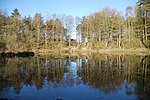Harburn, West Lothian

Harburn is a small village and estate in West Lothian, Scotland. It lies approximately 2 miles south-east of West Calder and just to the north of the Pentland Hills. The Harburn estate is a 19th century landscaped park and country house estate, primarily laid out in 1808. Harburn House is a Category B listed 18th century country-house that was built in 1804 for Alexander Young (1757-1842), factor to the Duke of Hamilton. It replaced an early property, Hayfield House and there are also records of a Harburn Castle, recorded as being fortified during Cromwell's invasions. The stables are also early 19th century and are Category B listed. In 1832, King Charles X of France visited Harburn and a monument to his visit, in the form of a stone column was erected.
Excerpt from the Wikipedia article Harburn, West Lothian (License: CC BY-SA 3.0, Authors, Images).Harburn, West Lothian
Geographical coordinates (GPS) Address Nearby Places Show on map
Geographical coordinates (GPS)
| Latitude | Longitude |
|---|---|
| N 55.8375 ° | E -3.531 ° |
Address
EH55 8RP
Scotland, United Kingdom
Open on Google Maps









